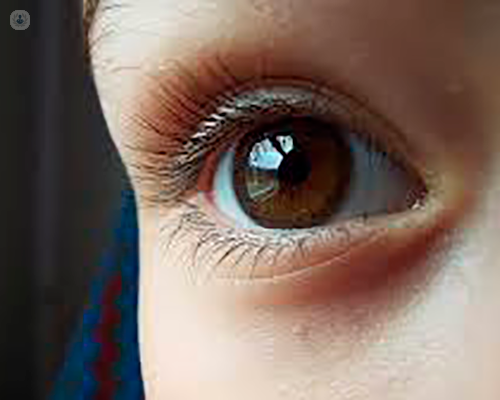What is blepharitis and how is it treated?
Escrito por:Blepharitis means lid inflammation, or more specifically, an inflammation of the lid margin. In each eyelid, we have 25 - 30 glands called Meibomian glands and in blepharitis the inflammation starts within these glands. Their role is to produce an oily layer that covers the tear film and prevents the tears from evaporating too quickly. In blepharitis, the Meibomian glands become inflamed and the secretions they produce become too thick and they fail to flow out of the glands and fail to reach the surface of the eyeball. As a result, the tear film evaporates too quickly and the eyes become gritty, uncomfortable and dry. Often this is associated with redness of the eye as the surface of the eyeball itself becomes inflamed as well. Dr Annegret Dahlmann-Noor, a leading ophthalmologist, explains what blepharitis is and gives us her expert advice on how to manage it.

What causes blepharitis?
Several factors contribute to the development of blepharitis:
- Environmental factors (working long hours indoors, in air-conditioned spaces, or staring at computers)
- Hormones
- Immune system
- Nutrition (fatty acids such as omega 3 & 9 can help to alleviate symptoms)
- Being female (it is more common in women ages 40 years upwards)
- Bacteria on the skin (people with blepharitis have more staphylococci on the lid margins than people who don't have blepharitis and this produces a toxin which is very irritant to the surface of the eye, causing inflammation of the conjunctiva: the white part of the eye, and even the cornea: the clear window at the front of the eye)
How is blepharitis treated?
The most important part of treating blepharitis is lid hygiene, in both adults and children. The minimum you should do if you have blepharitis are warm compresses and lid margin scrubbing every day for at least two minutes.
Warm compresses can be applied very simply. All you need to do is take a flannel, soak it in boiled water that has cooled down a bit, and then apply these compressors to the closed eyelids for at least two minutes at least once a day. This will dilate the Meibomian glands and it will soften the secretions that have become stuck, allowing them to flow out and onto the ocular surface more easily. In children, this can be difficult, but it can be combined with their bath time routine and can be turned into a peekaboo game, applying the warm compress to one eye at a time.
The two minutes of warm compresses should be followed by a thorough scrubbing of the lid margin. It needs to be quite a mechanical scrubbing effect to be effective, because bacteria on the lid margin secrete a bio-matrix - a sticky film that they are embedded in and that adheres to the lid margin. To carry out effective lid margin scrubbing, parents have told me that often it is easiest to use the same flannel. Again, wrap it around the index finger, soak it in warm water again, and then use it like a little brush to scrub along the line where the eyelashes are coming through the skin on the lower lid and on the upper lid, if possible. Another way for lid scrubbing is to soak a cotton bud in warm water and then use this to massage and scrub the lid margin.
What advice do you have for people suffering from blepharitis?
My advice for people who suffer from blepharitis, or for parents whose child suffers from blepharitis is to try simple measures first:
- Warm compresses every day
- Lid scrubbing every day
- Enriching the diet in essential fatty acids. Omega-3 and omega-9 essential fatty acids can be found in many vegetables and fish and legumes such as salmon, mackerel, avocados, flaxseed and linseed. In addition, many supplements are available particularly for children which contain these substances.
If these measures fail, I would recommend seeing a specialist. If there is inflammation of the surface of the eye (on the cornea), then eye-drops are needed to calm down this inflammation. In children, an oral medication can also be very effective and it has to be prescribed by a specialist and has to be taken for a prolonged period of time as blepharitis is a chronic condition that needs to be addressed patiently over time.
If you are affected by blepharitis and would like to find out more, make an appointment with a specialist.


